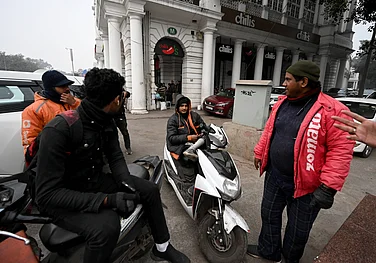India possesses the unenviable distinction of having the second worst air quality of any country in the world. This is not just a Delhi, urban, or North Indian problem—a staggering 84 per cent of the population breathes air that does not meet national standards. The effect is that the life expectancy of the average Indian is reduced by over five years on average from breathing dirty air.
The aftermath of the COVID-19 pandemic has made it more urgent than ever that we find different ways to clean the air, while also encouraging equitable economic growth. We suggest an important part of the solution could be a national cap-and-trade market to regulate sulphur dioxide (SO2) emissions from large industry and power-plants.
Why would regulating SO2 help? The single most important air pollutant in India is fine particulate matter (PM 2.5) which enters the air in two ways. The first is direct emission of particles created by burning fuels and crop-residue; construction activity; road dust etc. The second is indirectly, when other chemicals such as SO2 and nitrogen dioxide (NO2) react in the air to produce fine particles. About 30 per cent of PM 2.5 pollution across India is created this way, with the amount varying by location and season, sometimes as high as 70 per cent. Further, SO2 and NO2 can travel and turn into fine particles over many hundreds of kilometers, far from where they are emitted. This means they require national-level policy solutions.
Yet even though indirect particles are so important, they have generally not been targeted by policymakers and the result is predictable. India is the largest emitter of SO2 in the world, producing roughly 15 per cent of global emissions, almost entirely from the power and industry sector. Our power plants create roughly 80 per cent more SO2 per unit electricity than in China (countries like the United States are even cleaner). Even so, the Central Pollution Control Board has been forced to repeatedly extend compliance deadlines and relax limits in the face of consistent opposition by the power sector.
The compulsory installation of equipment to reduce SO2 has been opposed on both environmental and economic grounds. The environmental argument is that India’s air does not have high concentrations of SO2. This is highly misleading because it fails to recognize that SO2 turns into fine particles, and India’s air most certainly has too much PM 2.5. The economic argument is that these mandates impose large costs, especially on older coal fired plants. If this is true, then limiting SO2 through the proposed mandates might raise electricity prices and hurt growth.
The economic argument is important. It is true that environmental regulation in India still comprises primarily of inflexible equipment mandates or pollution limits. These tools make no distinction between those plants for whom cutting emissions is cheaper and easier, and those for whom the costs are so high that all operations might cease. This type of regulation is frequently more expensive than necessary, because it forces one-size-fits-all solutions, in a world where there are many ways to reduce pollution.
That said, the solution to costly regulation is not to have no regulation at all. Instead, we need to make regulation more efficient and flexible. A cap-and-trade market in SO2, covering power plants and large industry, would establish a strict limit on the total quantum of pollution that can be produced, but allow plants to buy and sell permits with each other. Newer plants or those for whom it is cheap to reduce SO2, could make larger reductions and be rewarded for this by being able to sell permits to those for whom pollution reduction is prohibitively expensive. This would minimize the costs on everyone and possibly lead to significant additional revenues through permit sales for those who can cut SO2 in innovative ways. It would open the possibility of using many methods, including fuel changes and abatement equipment, and provide a continuous incentive to make even small reductions, removing the all-or-nothing nature of currently proposed regulation.
India now has experience with this policy instrument, with a successful pilot having been implemented in Surat by the Gujarat Pollution Control Board. We estimate that an SO2 market restricted to the power sector, that cut emissions by 75 per cent, could lead to PM 2.5 reductions ranging from 5 to 15 per cent across large parts India. The opportunity to reduce both regulatory costs and life shortening PM2.5 pollution, through a single scheme, while benefiting more than just a few select cities, is worth seizing.
(Views are personal)
Prof. Michael Greenstone is the Milton Friedman Distinguished Service Professor in Economics and Director of the Energy Policy Institute at the University of Chicago.
Dr Anant Sudarshan is the South Asia Director of the Energy Policy Institute at the University of Chicago.





















